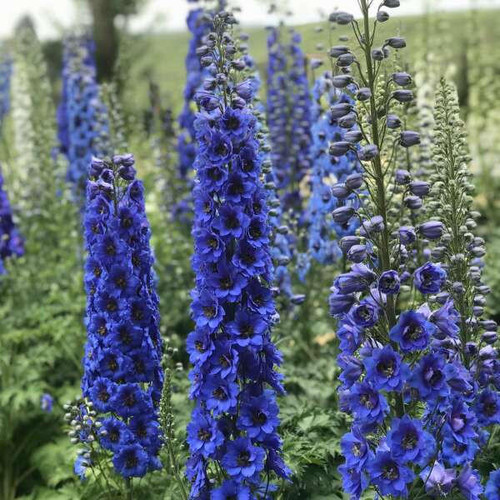Product Description
Delphinium e. 'Million Dollar Blue' (30)ct Flat
Common Name: Hybrid Bee Delphinium
Large spikes of semi-double to double true blue flowers have very erect stems. Strong stems carry the prominent blossoms above the dark green, deeply dissected foliage in early summer and then again in late summer or early fall. ‘Million Dollar Blue’ is very heat tolerant as well as being cold hardy to zone 3.
Height: 2.5-3.0 Feet; Spread: 1.5-2.0 Feet
Hardiness Zones: 3 - 7
Flower Color: Blue shades; Bloomtime: Early Summer to Early Fall
Foliage Color: Green shades
Sunlight: Full Sun to Part Shade
Average Water Needs
Average to Fertile Soil Quality
Attracts Butterflies and Hummingbirds
Deer and Rabbit Resistant
Dried Seed Heads
Border Plant,Cut Flower, Cut Foliage, Dried Flower, Mass Planting
Thirty (30) plants per flat (or tray). Approximate Plug Measurements: 3 inches deep x 2 inches wide.
Other Details
The most important part of the plant is its root system. Healthy roots are the foundation of a healthy, vibrant plant. The type of plug container used is based on the specific needs of the plants. Perennials offered as bare root traditionally perform better when planted as bare root.Planted in a specialized mix, potted plants have well established root systems. Top growth stage will vary depending on the current life cycle and time of year when shipped. In Winter and early Spring dormant plants may be shipped. Dormant plants may be planted right away, even before the last frost date.
Most bare root varieties are field grown for at least one season, though Hemerocallis and Hosta are grown for two seasons. The bulk of the soil is removed during the harvesting process and the tops of most varieties are trimmed back to the crown. They are graded, packed in shredded aspen or sphagnum moss and stored in freezers until ready to be shipped.
See our Container Sizes and Bare Root Perennials pages for more information.
Plant information and care is provided in the Overview section, Plant Genus Page and general information is provided in the Planting Care & Guides. Additional questions can be asked on each Plant page.
Plant Spacing: Using the maximum mature spread or width of a plant to guide spacing, ensures space to grow to full size. To fill an area sooner, plant them closer together. Just remember, future thinning or transplanting may be needed.
Water: Keep a close eye on newly planted perennials, especially throughout the first growing year. Most early plant loss is due to too much or too little water!










